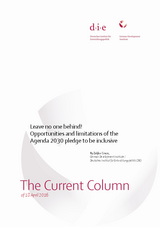The Current Column
Leave no one behind!
Crncic, ZeljkoThe Current Column (2016)
Bonn: German Development Institute / Deutsches Institut für Entwicklungspolitik (DIE) (The Current Column of 18 April 2016)
Officially adopted in New York on 25 September 2015, the United Nations Sustainable Development Goals (SDGs) contain a number of new features in relation to the Millennium Development Goals which they replace, not least the pledge to be inclusive. Specifically, this means that eight of the 17 SDGs explicitly include persons with disabilities among their target groups. So far, so good. However, it is the practical implementation of the SDGs which poses a challenge. For example, how is SDG 4 (“Quality Education”) to be realised, especially in states with a high level of economic and social inequality and/or political instability?
Education for all
Sustainable Development Goal 4 calls for the provision of education to all girls and boys by 2030. It has several targets and three means of implementation. Attaching greater importance to learning outcomes and cognitive skills than to mere school attendance, it seeks to ensure free, equitable, inclusive and quality education at primary and lower secondary level. SDG 4 is also intended to secure access to early-years services and pre-primary education, as well as to training and higher education. Another of its targets is to increase the number of young people taking up relevant employment and traineeships or setting up their own companies. It also aims to remove all obstacles to vulnerable groups, such as indigenous people and persons with disabilities, in the education sector. A further target is ensure that all youth and a substantial proportion of adults, both men and women, achieve literacy and numeracy by 2030.
Three means of implementation shall be used to make SDG 4 a reality. The first involves building educational institutions that are child and disability friendly and gender appropriate, or converting existing institutions to make them so. The second entails the significant expansion of scholarship programmes for learners from the global South by 2020, and the third consists of improving teacher training in developing countries.
Inclusive education in a difficult environment
But what does it look like to implement these ambitious, far-reaching targets, which also involve the inclusion of school pupils with disabilities, in a country such as Mexico? The Central American nation has been experiencing a wave of violence for years now. Over 100,000 people have been killed or have disappeared between 2006 and 2016 in the course of the conflict between state security forces and drug cartels. Mexico is also one of the Western Hemisphere countries in which economic wealth distribution is very uneven. Additionally, it suffers from widespread endemic corruption and clientelism. Clearly, delivering truly inclusive education in this kind of environment is very challenging to say the least, especially given that, for many years now, no statistics have been kept on the groups in need of inclusion. Several years ago, there were purported to be 20,000 school pupils with disabilities among the total 26 million school-age children in the country’s education system, but records of a more precise nature, for example, covering disability type, do not exist. Despite the many obstacles in their way, Mexican teachers, state and private educational institutions and civil society organisations have done an excellent job of educating girls and boys with disabilities in recent years. Nonetheless, there is still more to be done. There needs to be a change in attitude among the authorities so that they view inclusion as a human right rather than a goodwill gesture to be made at their discretion.
Additionally, a greater degree of reliability is required when putting together inclusive education plans to prevent them being forgotten about in a potentially new political climate after the next presidential election. After all, there is an urgent need to care for the social well-being and health of all people, including those with disabilities. In many instances, these individuals have to contend with a whole host of other problems at the same time, such as poverty, lack of health care and lawlessness. In this case, these issues compound the already difficult situation of individuals with disabilities.
There is still a risk that the target of inclusive education may remain a paper tiger in a jungle of poverty, inequality, violence and corruption. The goal of achieving education for all will only be realistic and achievable in Mexico if the country tackles its massive structural issues at the same time as promoting inclusion in the education sector. Were it to do so, then Mexico could become a role model for other countries in the region facing very similar problems when it comes to meeting the requirements for inclusive education.


